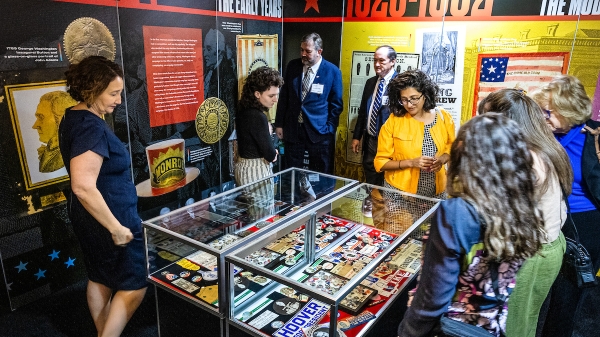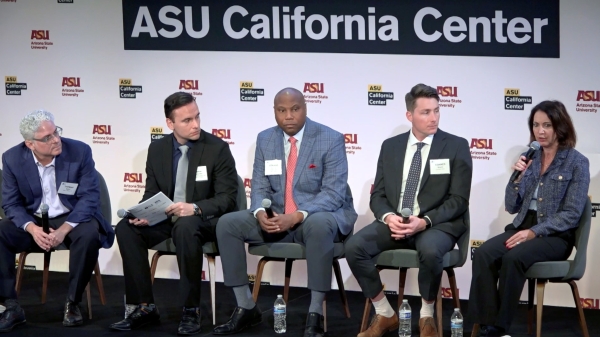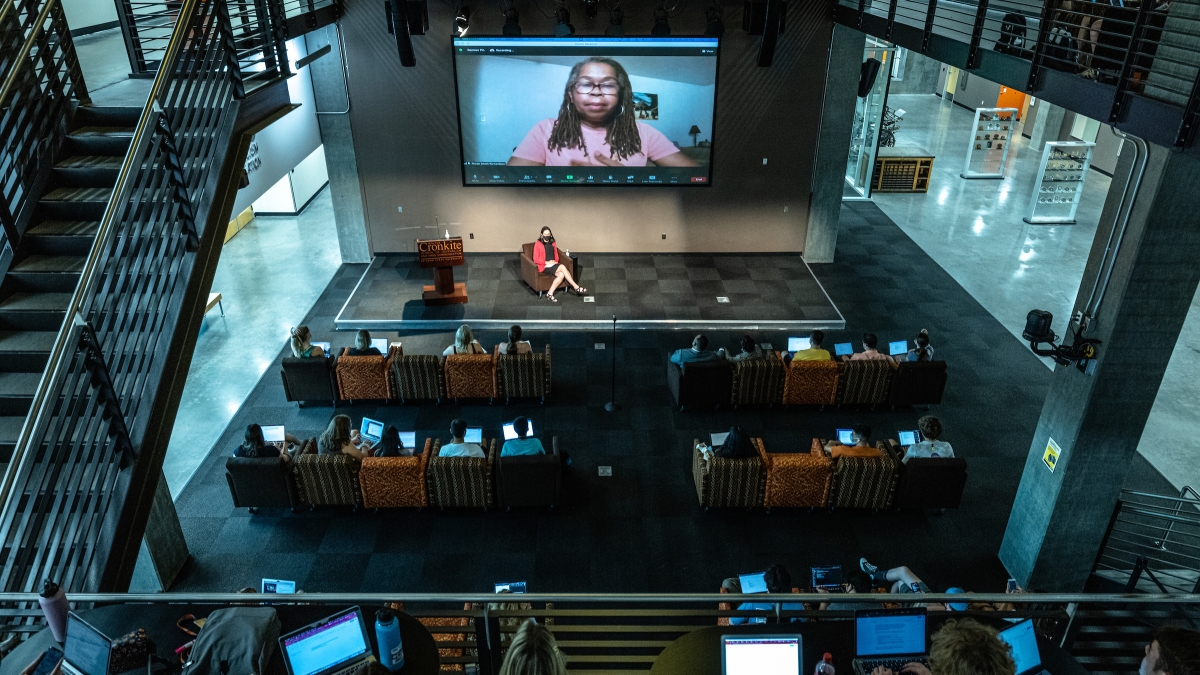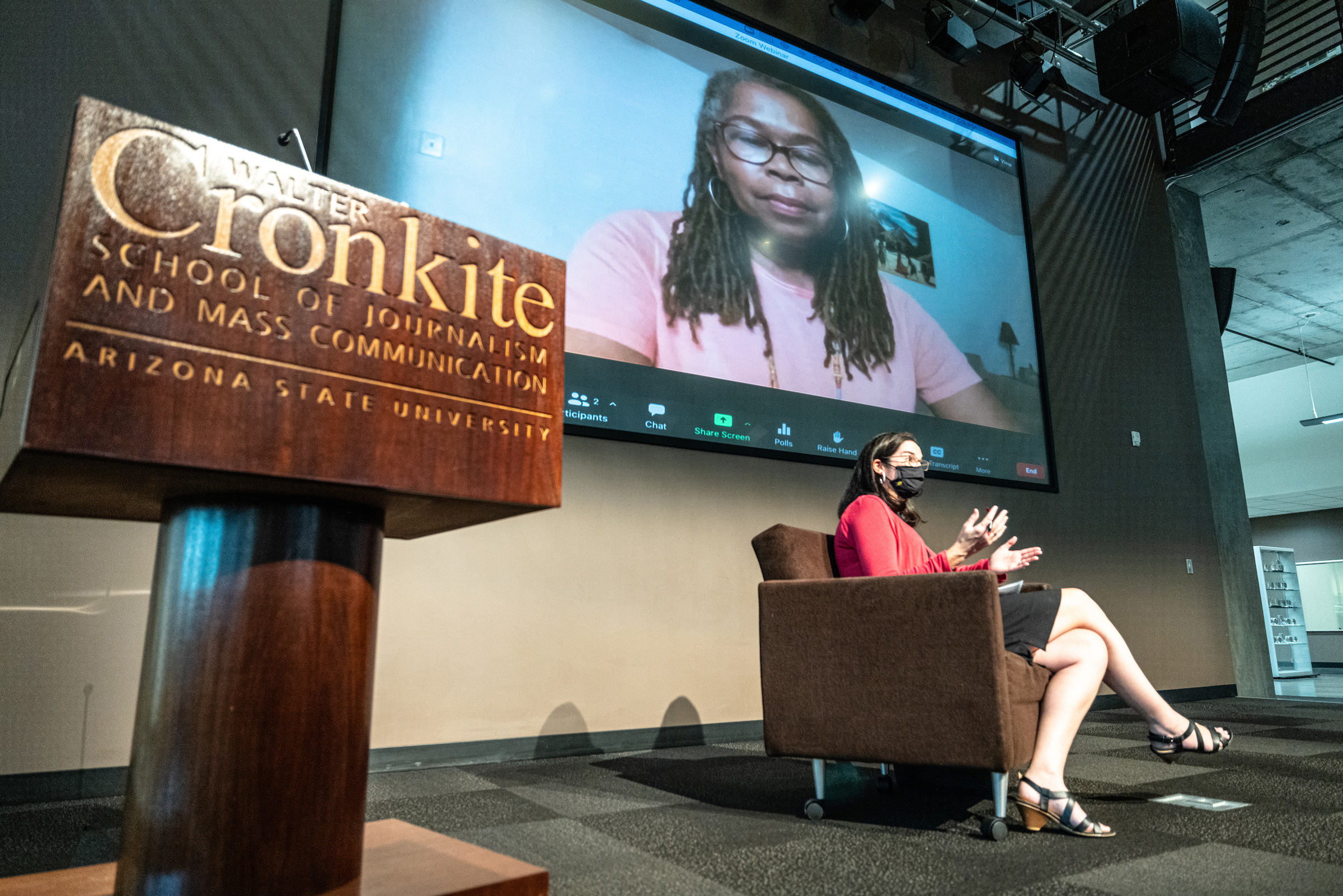Susan Smith Richardson, a nationally recognized journalist and media industry leader, said news organizations can support and improve reporting on communities of color by ensuring that their newsrooms are fair and equitable places to work.
“First and foremost, we have to scrutinize our own biases and know they exist,” said Richardson, who was named the inaugural Ida B. Wells Professor in Journalism at the Walter Cronkite School of Journalism and Mass Communication at Arizona State University in April. “We have to look at the systems and structures in place that disadvantage some and advantage others. … I always argue that a transparent organization has transparent job openings, has transparent criteria for being promoted, has transparency for being hired. These things help people of color and people who have historically been underrepresented — but they also help the entire newsroom get better.”
Richardson’s Sept. 20 talk was part of the fall 2021 “Must See Mondays” lecture series hosted by the Cronkite School in the First Amendment Forum on the Downtown Phoenix campus. Richardson joined the livestreamed event via Zoom from New York, where she is based.
Her Cronkite School position was created in honor of Wells, an African American investigative journalist, educator and early leader in the civil rights movement. This fall, Richardson is teaching media leadership and transformation to Cronkite School graduate students, and, in spring 2022, she will teach an advanced reporting class for undergraduate and graduate students.
"The legacy of Ida B. Wells endures and continues to inspire young and veteran journalists alike,” said Senior Associate Dean Rebecca Blatt, who served as moderator at Monday's event. “I look forward to honoring that legacy and discussing its relevance to the racial justice movements of our time.”
Blatt and Richardson spent the first portion of the evening discussing the importance and impact of Wells’ reporting and legacy.
“Without dispute, (Wells) was one of the most important journalists of the late 19th and early 20th centuries,” Richardson said. “Her work is so important because her campaign against lynchings did two things: It exposed the misinformation about the causes of lynchings, and it also documented the widespread nature of lynchings as a form of terror. This, in its earliest form, is investigative journalism.”
Susan Smith Richardson, deputy editor of The Guardian US and the first Ida B. Wells Professor in Journalism, talks with Senior Associate Dean Rebecca Blatt (seated) during a Must See Mondays event,Sept. 20, at the Walter Cronkite School of Journalism and Mass Communication. Photo by Charlie Leight/ASU News
The discussion quickly turned to Richardson’s career, which she said dates back to the late 1980s.
Richardson is currently the deputy editor at The Guardian US, where her responsibilities include diversity, equity and inclusion efforts as well as developing coverage on race, identity, power and inequality. She is also working to develop collaborations between the British news company and the Cronkite School.
She has been a senior manager and editor at some of the nation’s top media outlets. She was chief executive officer of the Center for Public Integrity in Washington, D.C., a leading nonprofit investigative journalism organization, and editor and publisher of The Chicago Reporter, renowned for its coverage of race, poverty and income inequality. She also served as editorial director of the Solutions Journalism Network, a nonprofit organization that advocates a solutions-based approach to reporting on social problems. Earlier in her career, she worked as assistant metro editor of the Chicago Tribune, managing editor of The Texas Observer and senior writer at the MacArthur Foundation.
Richardson said journalism can’t be disconnected from serving communities and that critical issues must be identified and given voice.
“We’re having a renewed conversation about our relationship with communities in a deeper and more meaningful way,” Richardson said. “Our responsibility as a group of professionals with the big ol’ megaphone is to really cast light on some of the issues that society would rather ignore.”
That means confronting issues surrounding class, race, gender, inequity, inclusion and transparency, especially in the newsroom.
“There is no final destination when it comes to creating a representative and inclusive newsroom where people feel a sense of belonging,” Richardson said. “That is a 24/7, 365-days-a-year work. You never stop because the goal is never reached. And if you think you could hit a point, then you’re wrong.”
Richardson said good journalism starts with a conversation or hypothesis in the newsroom so that when a story breaks, the reporter is equipped with the knowledge to report on a story with depth and clarity. She added that the best investigative stories that catch on with the public usually have elements of intersectionality. Richardson pointed to a story she wrote on a prison bus service that included issues surrounding transportation, economics, race, gender, equity and class structure.
“Over time what I’ve learned as a journalist is that if you pull the thread, even gently, you’re going to see that it connects with something that you think is unrelated,” Richardson said. “All issues are connected to a system, and systems imply there’s an interconnection between issues. … If we’re reminded of that, then I think as reporters we’re all prepared to cover things more comprehensively.”
As for the future of the journalism, Richardson believes it will be bright and that she and her journalism students will help figure it out.
“If you want to be in a learning environment, you get in an environment with another generation,” Richardson said. “They’re very much a part of shaping it. So how they view and shape the world and see journalism is a way for me to get educated as well. It’s a two-way street.”
Top photo: Susan Smith Richardson (on screen), deputy editor of The Guardian and the first Ida B. Wells Professor in Journalism, talks with Senior Associate Dean Rebecca Blatt during the Must See Mondays event Monday, Sept. 20, in the First Amendment Forum in the Walter Cronkite School of Journalism and Mass Communication in Phoenix. Among the topics covered, Richardson discussed how news organizations can support and improve reporting on communities of color. Photo by Charlie Leight/ASU News
More Law, journalism and politics

Exhibit uses rare memorabilia to illustrate evolution of US presidential campaigns
After one of the most contentious elections in history, a new museum exhibit offers a historical perspective on the centuries-old American process.“We The People! Electing the American President” had…

TechTainment conference explores the crossroads of law, technology, entertainment
What protections do writers, actors, producers and others have from AI? Will changing laws around name, image and likeness (NIL) eliminate less lucrative college sports programs?And what does…

How to watch an election
Every election night, adrenaline pumps through newsrooms across the country as journalists take the pulse of democracy. We gathered three veteran reporters — each of them faculty at the Walter…

